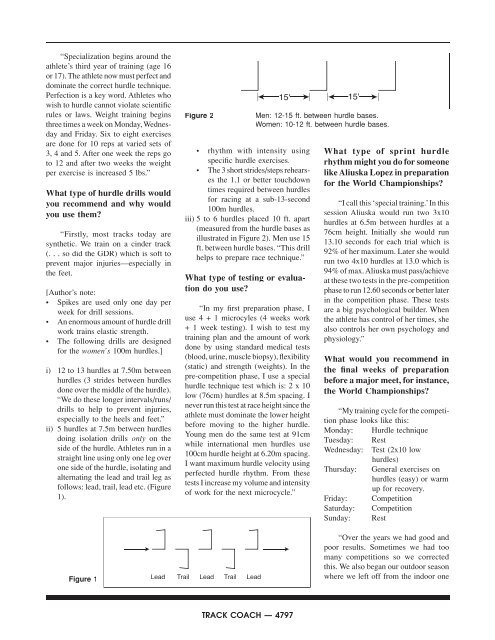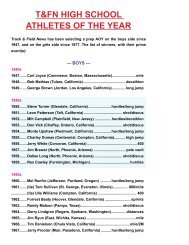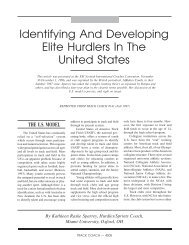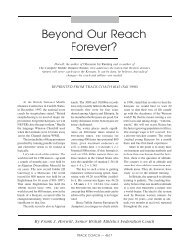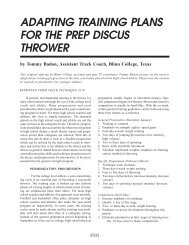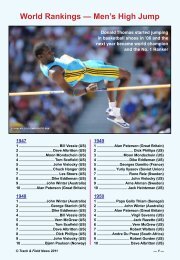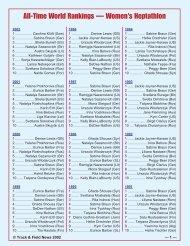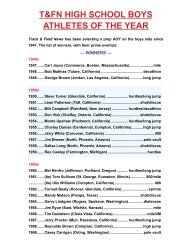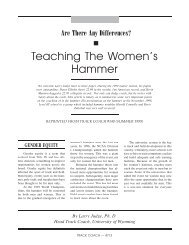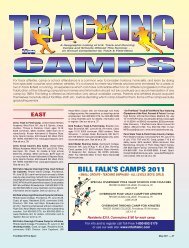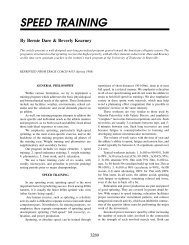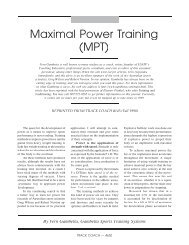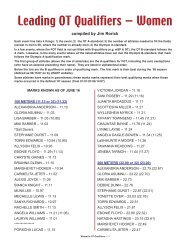A Talk With Cuban Coach Santiago Antunez - Track & Field News
A Talk With Cuban Coach Santiago Antunez - Track & Field News
A Talk With Cuban Coach Santiago Antunez - Track & Field News
You also want an ePaper? Increase the reach of your titles
YUMPU automatically turns print PDFs into web optimized ePapers that Google loves.
“Specialization begins around the<br />
athlete’s third year of training (age 16<br />
or 17). The athlete now must perfect and<br />
dominate the correct hurdle technique.<br />
Perfection is a key word. Athletes who<br />
wish to hurdle cannot violate scientific<br />
rules or laws. Weight training begins<br />
three times a week on Monday, Wednesday<br />
and Friday. Six to eight exercises<br />
are done for 10 reps at varied sets of<br />
3, 4 and 5. After one week the reps go<br />
to 12 and after two weeks the weight<br />
per exercise is increased 5 lbs.”<br />
What type of hurdle drills would<br />
you recommend and why would<br />
you use them?<br />
“Firstly, most tracks today are<br />
synthetic. We train on a cinder track<br />
(. . . so did the GDR) which is soft to<br />
prevent major injuries—especially in<br />
the feet.<br />
[Author’s note:<br />
• Spikes are used only one day per<br />
week for drill sessions.<br />
• An enormous amount of hurdle drill<br />
work trains elastic strength.<br />
• The following drills are designed<br />
for the women’s 100m hurdles.]<br />
i) 12 to 13 hurdles at 7.50m between<br />
hurdles (3 strides between hurdles<br />
done over the middle of the hurdle).<br />
“We do these longer intervals/runs/<br />
drills to help to prevent injuries,<br />
especially to the heels and feet.”<br />
ii) 5 hurdles at 7.5m between hurdles<br />
doing isolation drills only on the<br />
side of the hurdle. Athletes run in a<br />
straight line using only one leg over<br />
one side of the hurdle, isolating and<br />
alternating the lead and trail leg as<br />
follows: lead, trail, lead etc. (Figure<br />
1).<br />
Figure 2<br />
• rhythm with intensity using<br />
specific hurdle exercises.<br />
• The 3 short strides/steps rehearses<br />
the 1.1 or better touchdown<br />
times required between hurdles<br />
for racing at a sub-13-second<br />
100m hurdles.<br />
iii) 5 to 6 hurdles placed 10 ft. apart<br />
(measured from the hurdle bases as<br />
illustrated in Figure 2). Men use 15<br />
ft. between hurdle bases. “This drill<br />
helps to prepare race technique.”<br />
What type of testing or evaluation<br />
do you use?<br />
“In my first preparation phase, I<br />
use 4 + 1 microcyles (4 weeks work<br />
+ 1 week testing). I wish to test my<br />
training plan and the amount of work<br />
done by using standard medical tests<br />
(blood, urine, muscle biopsy), flexibility<br />
(static) and strength (weights). In the<br />
pre-competition phase, I use a special<br />
hurdle technique test which is: 2 x 10<br />
low (76cm) hurdles at 8.5m spacing. I<br />
never run this test at race height since the<br />
athlete must dominate the lower height<br />
before moving to the higher hurdle.<br />
Young men do the same test at 91cm<br />
while international men hurdles use<br />
100cm hurdle height at 6.20m spacing.<br />
I want maximum hurdle velocity using<br />
perfected hurdle rhythm. From these<br />
tests I increase my volume and intensity<br />
of work for the next microcycle.”<br />
Men: 12-15 ft. between hurdle bases.<br />
Women: 10-12 ft. between hurdle bases.<br />
What type of sprint hurdle<br />
rhythm might you do for someone<br />
like Aliuska Lopez in preparation<br />
for the World Championships?<br />
“I call this ‘special training.’ In this<br />
session Aliuska would run two 3x10<br />
hurdles at 6.5m between hurdles at a<br />
76cm height. Initially she would run<br />
13.10 seconds for each trial which is<br />
92% of her maximum. Later she would<br />
run two 4x10 hurdles at 13.0 which is<br />
94% of max. Aliuska must pass/achieve<br />
at these two tests in the pre-competition<br />
phase to run 12.60 seconds or better later<br />
in the competition phase. These tests<br />
are a big psychological builder. When<br />
the athlete has control of her times, she<br />
also controls her own psychology and<br />
physiology.”<br />
What would you recommend in<br />
the final weeks of preparation<br />
before a major meet, for instance,<br />
the World Championships?<br />
“My training cycle for the competition<br />
phase looks like this:<br />
Monday: Hurdle technique<br />
Tuesday: Rest<br />
Wednesday: Test (2x10 low<br />
hurdles)<br />
Thursday: General exercises on<br />
hurdles (easy) or warm<br />
up for recovery.<br />
Friday: Competition<br />
Saturday: Competition<br />
Sunday: Rest<br />
Figure 1<br />
Lead Trail Lead Trail Lead<br />
“Over the years we had good and<br />
poor results. Sometimes we had too<br />
many competitions so we corrected<br />
this. We also began our outdoor season<br />
where we left off from the indoor one<br />
TRACK COACH — 4797


